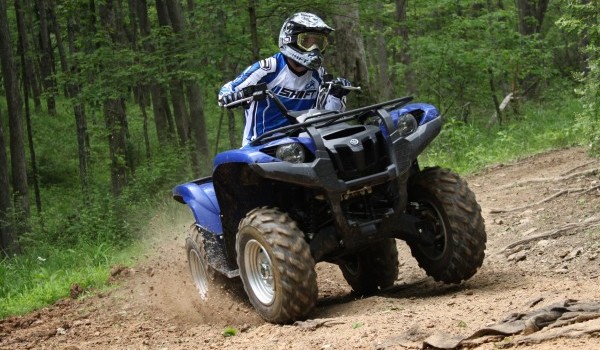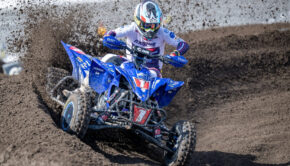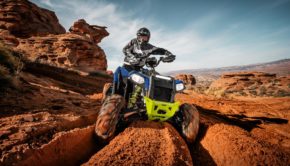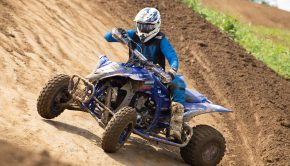2011 Yamaha Grizzly 700 Test
Introduced back in 2006 for the 2007 model year, Yamaha’s Grizzly 700 hit the market as the first ATV to offer power steering. Since then, it has won a ton of Big-Bore shootouts and set the standard for its class in many ways.
Last year we tested the Grizzly 550. We were blown away by what a capable all-around machine the 550 was, especially when it came to having fun out on the trail. The Grizzly 550 was based on, and is virtually identical to, its slightly older sibling, the Grizzly 700. The only real difference between the two machines, is a bit more displacement and power for the 700. We loved the sporty, nimble handing of the 550, and knew that more power would only up the fun factor, so we decided to grab a 2011 Grizzly 700 and revisit what makes this ATV so popular with so many riders.
Technical Breakdown

The Grizzly 700’s engine shares much of its design and technology with Yamaha’s phenomenal Raptor 700 sport ATV.
The Grizzly 700’s engine shares much of its design and technology with Yamaha’s phenomenal Raptor 700 sport ATV. The 700’s engine displaces 686cc, and features a four-valve, single overhead cam design, A ceramic lined cylinder, forged piston, and chromoly connecting rod work together to reduce weight and heat, while maximizing durability. A Makuni fuel injection system regulates the air fuel mixture, which is fed to the engine by a 44mm throttle body. Push button electric starting brings the engine to life.
The Grizzly’s fully automatic transmission features both high and low range, plus neutral, reverse, and park, selected by a compact, gated shifter. The CVT Transmission features an automatic centrifugal clutch, which maintains constant belt tension for reduced belt wear. Additionally, the drive case is sealed to keep out water and debris.
 Yamaha’s electronic servo activated, On-Command, four-wheel drive system allows you to choose between two-wheel drive, four-wheel drive, and four-wheel drive with front differential lock. The Grizzly features the most slick operating drive selector switch on the market, looking and functioning like something out of a fighter jet.
Yamaha’s electronic servo activated, On-Command, four-wheel drive system allows you to choose between two-wheel drive, four-wheel drive, and four-wheel drive with front differential lock. The Grizzly features the most slick operating drive selector switch on the market, looking and functioning like something out of a fighter jet.
A tubular steel frame mates up to dual A-arms at both ends. Yamaha’s WideArc, front A-arms provide maximum ground clearance over a wider area, with the undercarriage featuring a very healthy 11.8 inches of ground clearance. At 46.5 inches wide, the Grizzly’s width is typical of its class; however, its wheelbase is one to two inches shorter than most at 49.2 inches.
 Five-way, preload-adjustable shocks at all four corners provide some tunability. Suspension travel numbers are very respectable–– 7.1 inches up front and a lengthy 9.5 inches out back.
Five-way, preload-adjustable shocks at all four corners provide some tunability. Suspension travel numbers are very respectable–– 7.1 inches up front and a lengthy 9.5 inches out back.
Yamaha was the first ATV manufacturer to bless enthusiasts with easy steering and the reduction in steering feedback provided by electric power steering. Yamaha’s system measures vehicle speed and torque applied to the steering through the handlebars and impacts with the front wheels, helping optimize the EPS’ effectiveness. As speeds increase, the power steering’s assistance decreases, preventing the twitchy feeling found with some systems.
To minimize the feeling of the Grizzly’s lightweight, Yamaha paid a lot of attention to mass centralization, moving as much weight as possible to the center of the machine. The cylinder was tilted forward 35-degrees, allowing for higher ground clearance and a low seat height of 35.6 inches. To further help lower the center of gravity, the 5.3 gallon fuel tank was located under the seat, although filling takes place under a flip up panel in front of the seat where you would expect the fuel tank to be.

Yamaha was the first ATV manufacturer to bless enthusiasts with easy steering and the reduction in steering feedback provided by electric power steering.
Independently operated hydraulic disc brakes slow the 700 and are operated by the handlebar-mounted levers, and the right side mounted foot pedal. Assisting the brakes is an engine braking system, providing four-wheel braking when four-wheel drive is engaged.
The 700’s steel racks are coated with a wrinkle paint finish and feature 99 pounds of capacity up front and 187 pounds in the rear. The Grizzly can tow an additional 1300 pounds with its center mounted trailer hitch. There’s enough dry storage for a few pairs of gloves, goggles, or a rain parka, available in the right front fender’s storage compartment.
 Front 25×8-12 and rear 25×10-12 Dunlop tires are mounted on basic, lightweight, aluminum wheels, which are dressed up by Yamaha emblem center caps. The Grizzly’s digital instrument display is one of our favorites. It’s easy to read and Yamaha was smart enough to mount it on the front bodywork, not on the handlebars like so many others. This allows you to select an aftermarket handlebar without fear of having to relocate or remove your instruments.
Front 25×8-12 and rear 25×10-12 Dunlop tires are mounted on basic, lightweight, aluminum wheels, which are dressed up by Yamaha emblem center caps. The Grizzly’s digital instrument display is one of our favorites. It’s easy to read and Yamaha was smart enough to mount it on the front bodywork, not on the handlebars like so many others. This allows you to select an aftermarket handlebar without fear of having to relocate or remove your instruments.
The Test
We have spent the last few months putting several hundred miles on our Grizzly. It’s been ridden at Wilderness Trail off-road Park, in southeast Kentucky; we’ve taken it on several one-day rides; and used it as a camera mule while testing other models.
The Grizzly starts reliably regardless of temperature, thanks to its fuel injection. The engine warms up quickly and is ready to go, even in freezing temperatures.

There was plenty of power for steep climbs, and to spin the stock tires in deep mud or out of corners,
Power output alone doesn’t define the Grizzly 700, although it delivers adequate power for work applications or fast trail rides. It feels a lot like the Grizzly 550, producing smooth power throughout the RPM range; the only difference being that the 700 produces a bit more torque, most notably in the bottom end and lower midrange part of the RPMs. There was plenty of power for steep climbs, and to spin the stock tires in deep mud or out of corners, but it lacks the arm stretching pull and excessive power of the big bore twin cylinders.

High range was ideal for all but the slowest of situations, and low range makes the Grizzly feel unstoppable while working, or negotiating, a tough climb.
CVT engagement is smooth with little lag. High range was ideal for all but the slowest of situations, and low range makes the Grizzly feel unstoppable while working, or negotiating, a tough climb. The Grizzly’s drive system is near perfection. Two-wheel drive allows you to cruise along, braking the rear wheels loose for slides on-demand. Cruising slippery, unpredictable, trails in four-wheel drive, provides the security of additional traction, while having virtually no effect on steering effort. Of course, differential lock is available for the most demanding of situations. Obtaining full power with the differential lock engaged requires you to push an override button on the left handlebar. We say ditch the rev limiter and override button altogether.

Combine the Grizzly’s engine and transmission, with its light and nimble chassis, and you have one of the most fun to ride big bore 4x4s on the market.
Combine the Grizzly’s engine and transmission, with its light and nimble chassis, and you have one of the most fun to ride big bore 4x4s on the market. Yamaha’s extensive mass centralization results in a light and nimble feeling machine, on the ground and even in the air! We have ridden some compact, small bore 4x4s that feel significantly heavier than the 700. With good technique, or a small bump in the trail, you can easily wheelie the Grizzly out of corners or over small logs. On climbs, the front end feels predictably planted, unless you find a sapling you’d rather leap over.
The Grizzly’s nimble feeling carries into corners, steering quick and precisely, pushing only a small amount when ridden hard. It exhibits some front-end body roll if you drive too hard through turns. In spite of its high ground clearance and long travel IRS, the Grizzly is an easy and predictable power slider. Lean in and crack the throttle, and you can overcome the front-end dive by freeing up the back end! There’s no need to wait for Yamaha to release a big bore sport 4×4, because if they did, here’s betting it would handle a lot like the Grizzly 700.

The Grizzly’s nimble feeling carries into corners, steering quick and precisely, pushing only a small amount when ridden hard.
For trail riding, Yamaha has, in our opinion, the best power steering unit on the market. It’s so good, because you never notice it. Steering effort is light, but never too light. Jarring impacts with trail obstacles aren’t transferred back to the handlebars, but you receive enough feedback that you still feel connected to the trail. Power steering also reduces the machine’s tendency to follow tire or water ruts, allowing you to more easily maintain line selection. The EPS reduces its effort at higher speeds, preventing it from feeling twitchy at speed. If we could ask for more from Yamaha’s EPS, it would be for it to offer assistance while sitting still or moving at a snail’s pace, for specific work applications or extra help when you’re hung up on a huge log.
The suspension action lends itself to the Grizzly’s nimble, sporty handling. The shocks provide a firm, yet never jarring, ride over protruding rocks and roots. Square edge hits from ruts and saplings are eaten up, and well-landed leaps are easily absorbed. Whoops can get a bit bouncy, but the lightness of the Grizzly allows you to hammer through more easily than on some of its more portly competitors. Overall, we found the front to be a bit softer than the rear, and adding a notch or two of preload to the front shocks helps.
We don’t need a shootout to tell you who has the best brakes in the Big- Bore class. The Grizzly’s offer power and feel on par with sport quad brakes. They are strong and silent in both wet and dry conditions. While the rear brakes may need maintenance more often than the sealed, rear, disc brakes found on other models, their light engagement and superior feel more than make up for having to occasionally replace brake pads. Being able to operate the brakes independently enhances control, becoming more of a benefit the more technical the trail becomes.
Yamaha’s engine braking system is extremely effective on downhills, allowing you to crawl down in low range. Four-wheel braking is a benefit on moderately steep, slippery descents; however, we would recommend disengaging four-wheel drive for the very steepest descents where you might not want engine braking to the front wheels. Chopping the throttle at speed, the engine brake feels very similar to letting off the gas on a manual shift machine, with smooth and predictable deceleration.
While it’s hard to get excited about the Grizzly’s wheel and tire package, it’s hard to fault them. The Dunlops seemed to work well in every situation, and we felt that they were, in part, responsible for the machine’s good sliding characteristics. They could, perhaps, be partly to blame, though, for some of the front-end body roll. Being light, the tires may not be the most puncture resistant, but we never flattened one. The wheels are kind of plain, but they are light, helping performance.
The Grizzly’s ergonomics are quite good. The relationship between the bars, seat, and floorboards with raised steel foot pegs, is comfortable for casual or aggressive riding. The machine feels reasonably narrow between your legs and its side panels provide a smooth, contoured surface you can grip with your knees. The controls, levers, and grips are flawless. While the seat is plush, the transition between it and the bodywork in front of it is a bit abrupt.
For utility purposes, tubular steel racks are the way to go. The Yamaha’s were easy to attach items to regardless of size or shape. The front is winch mount equipped and this chassis does a good job holding up the weight of a plow, thanks to its adjustable front shocks.
The Bottom Line
 The Yamaha Grizzly 700 is a great machine for many riders. There are machines that do certain things better, but there are few that do so many things so well. The Grizzly’s overall package is tough to beat and that’s why it has won so many shootouts through the years.
The Yamaha Grizzly 700 is a great machine for many riders. There are machines that do certain things better, but there are few that do so many things so well. The Grizzly’s overall package is tough to beat and that’s why it has won so many shootouts through the years.
Sport 4×4 guys looking to modify the Grizzly will be pleased with the number of performance parts available from the aftermarket. If there is work to be done, the Grizzly is a hard worker that won’t wear you out.
There are other good Big-Bore 4×4’s on the market that won’t go down as one of the greatest ATV’s of all time. The Grizzly 700 is a great one that will.
2011 Yamaha Grizzly 700 Review
Summary: The Yamaha Grizzly 700 is a great machine for many riders. There are machines that do certain things better, but there are few that do so many things so well. The Grizzly’s overall package is tough to beat and that’s why it has won so many shootouts through the years.













